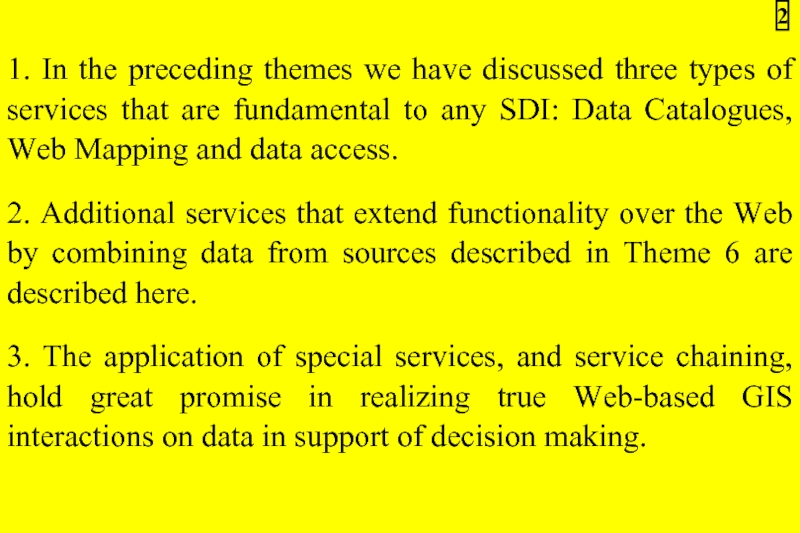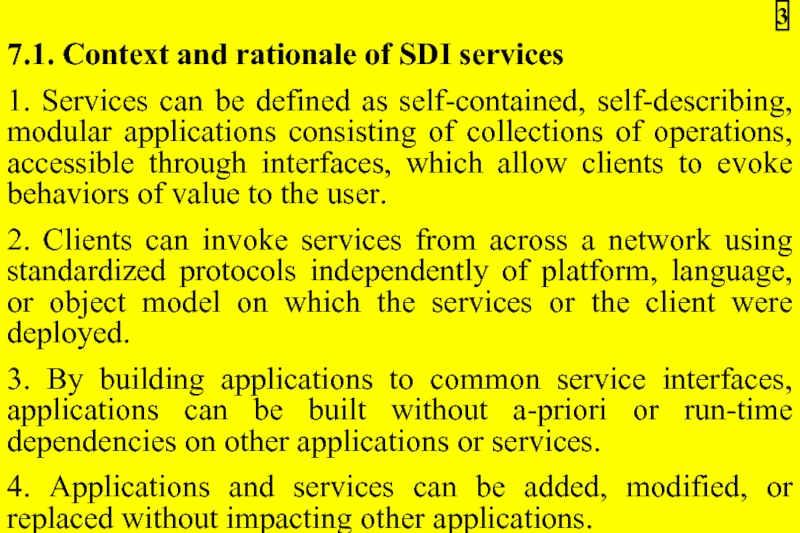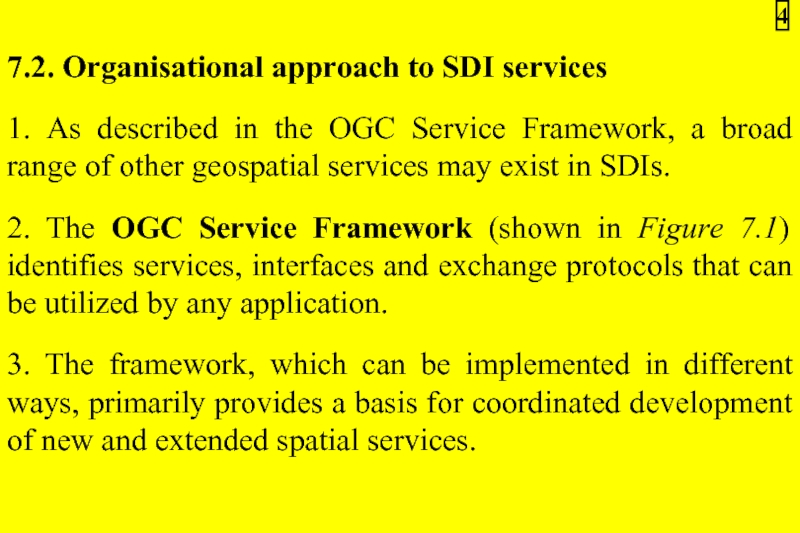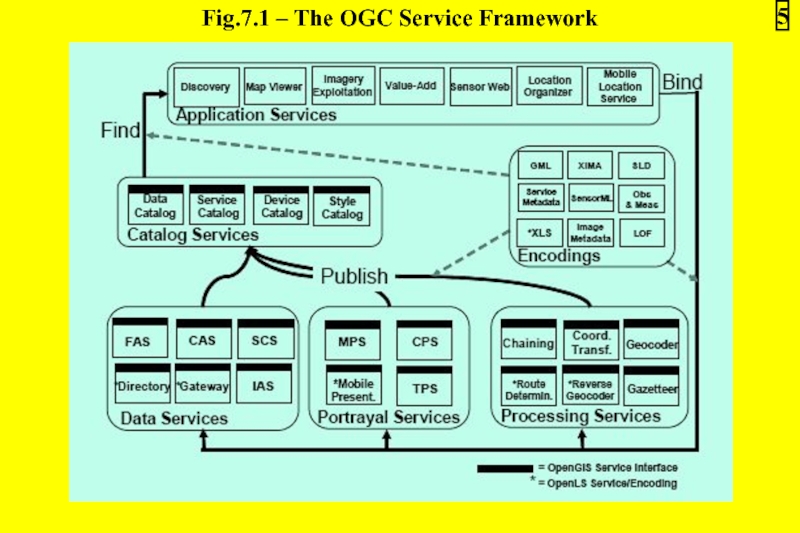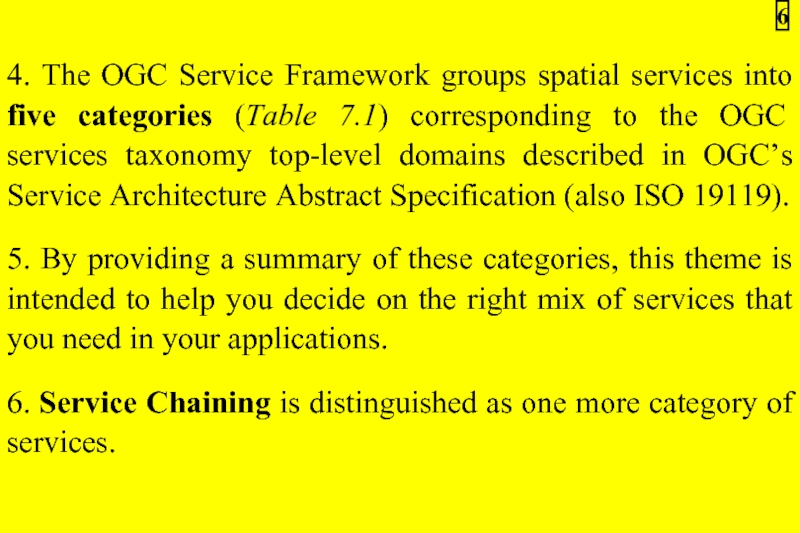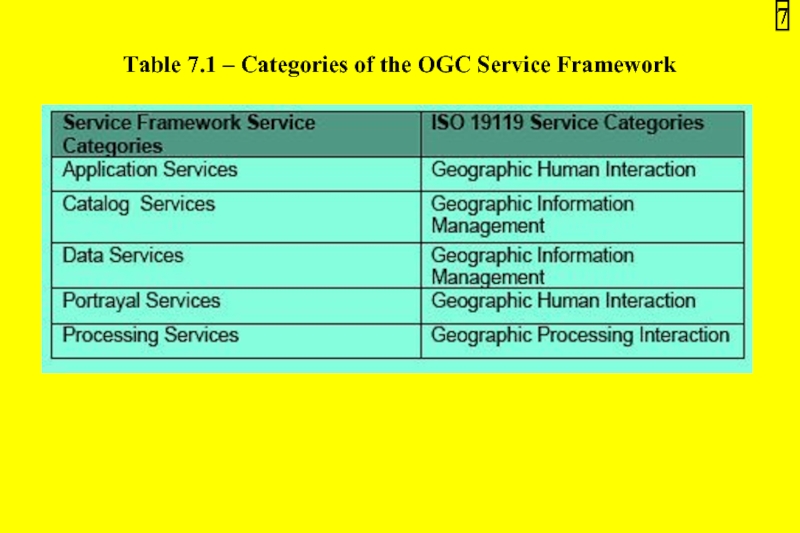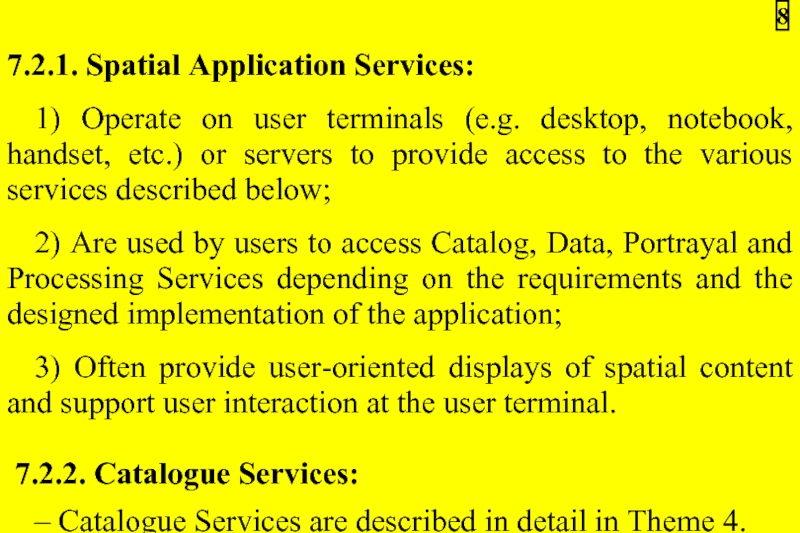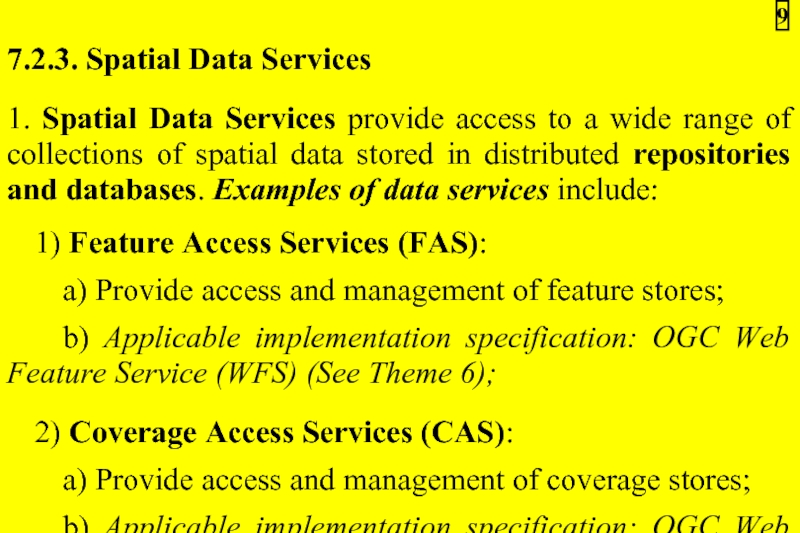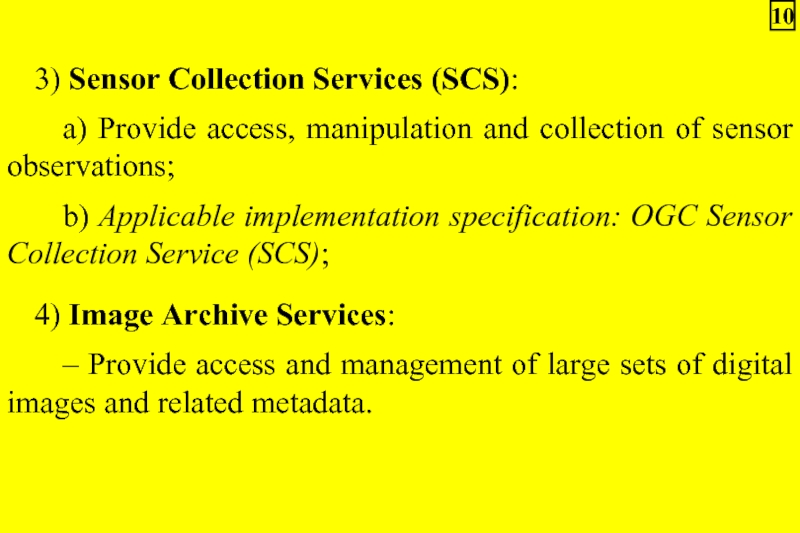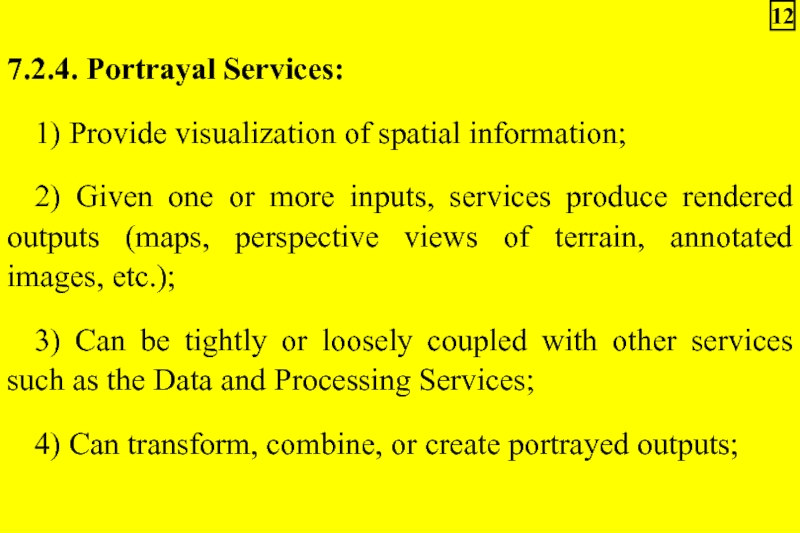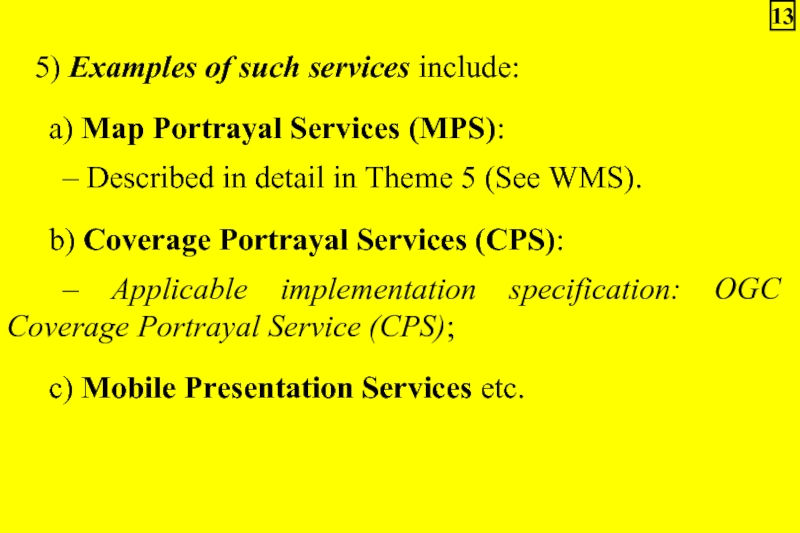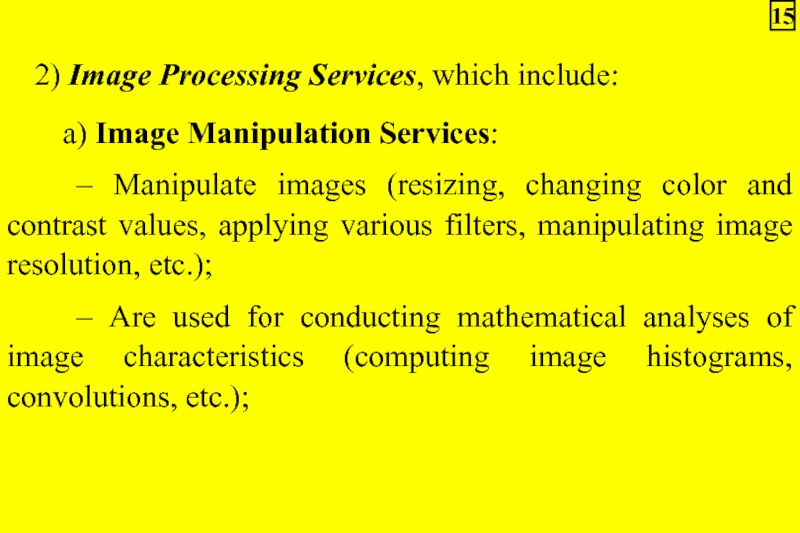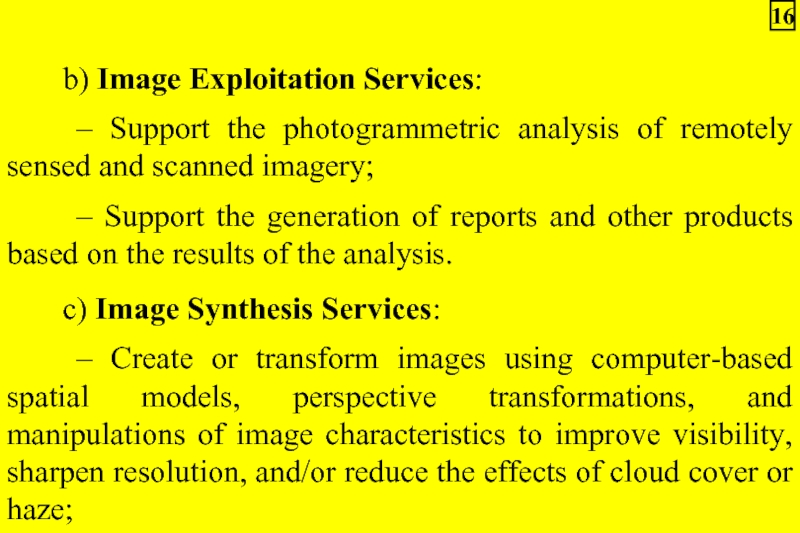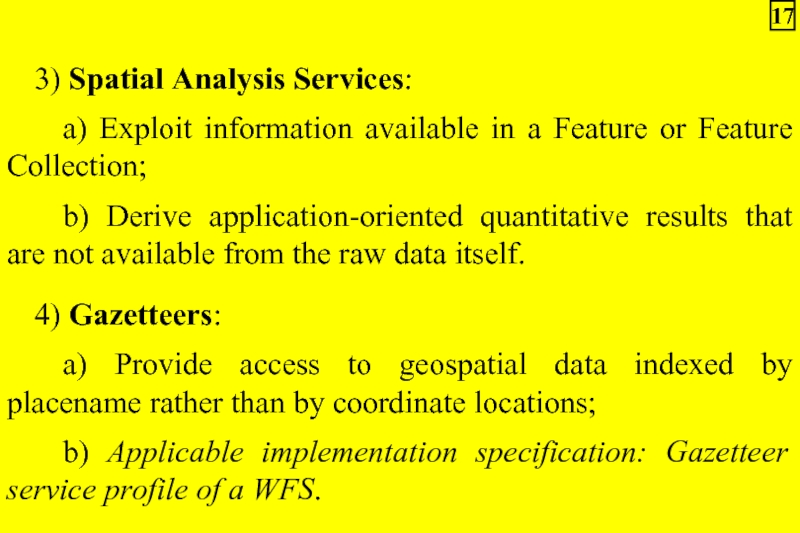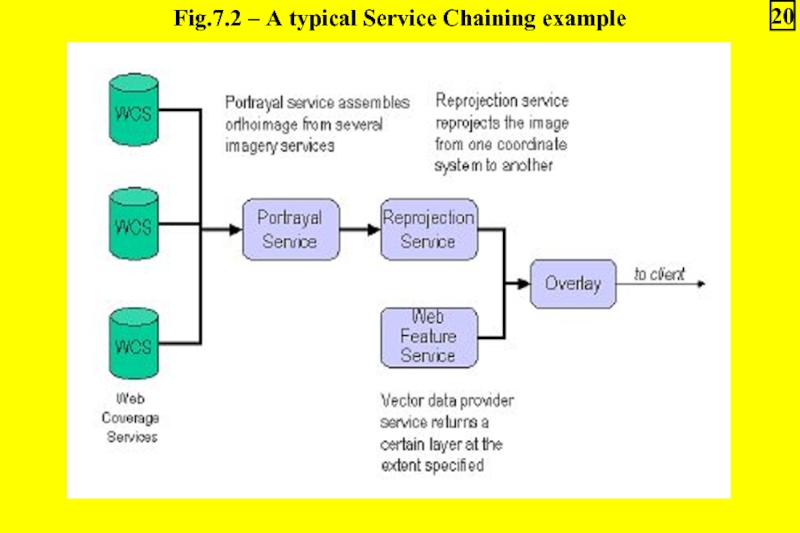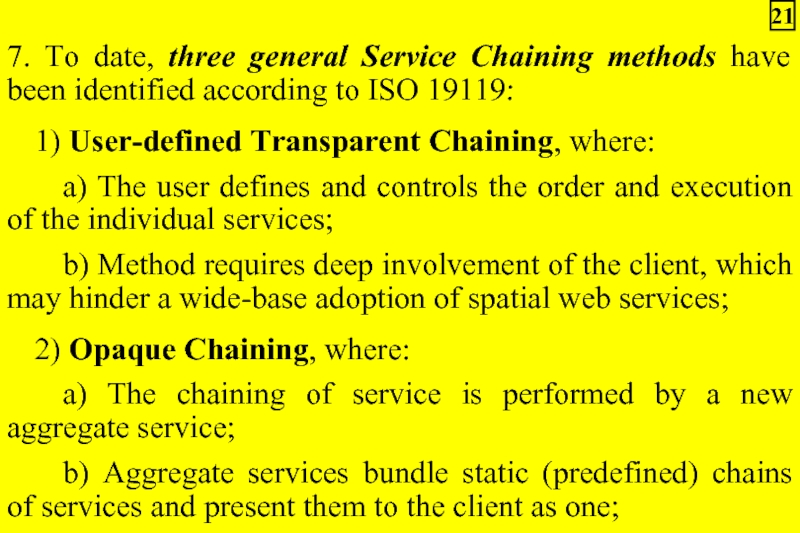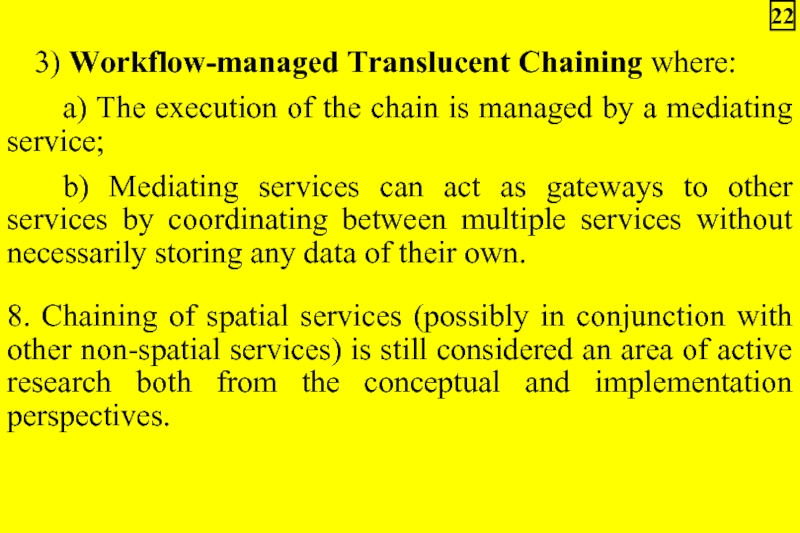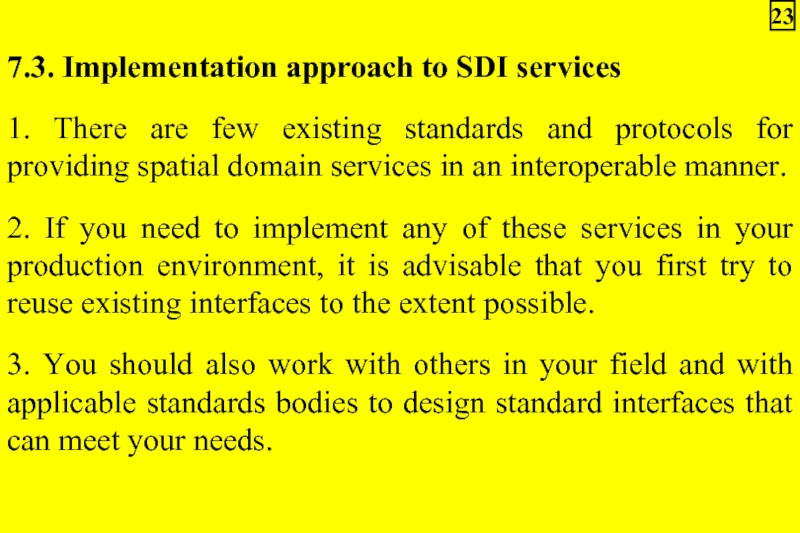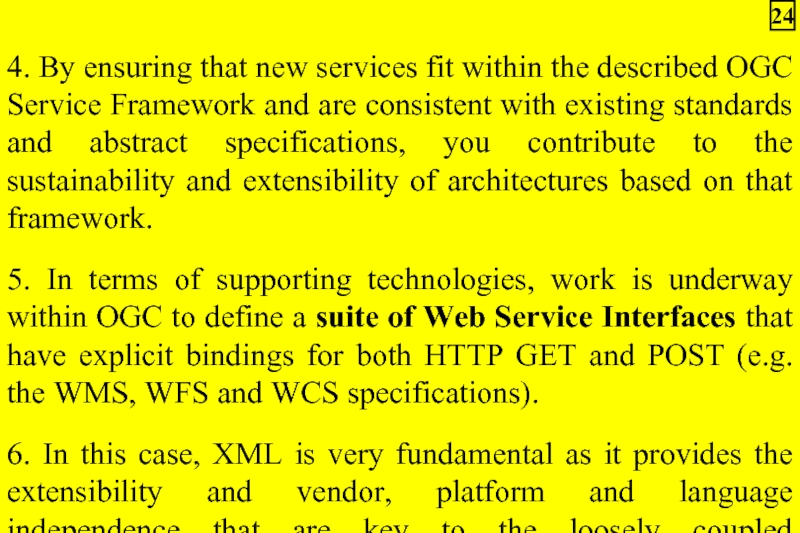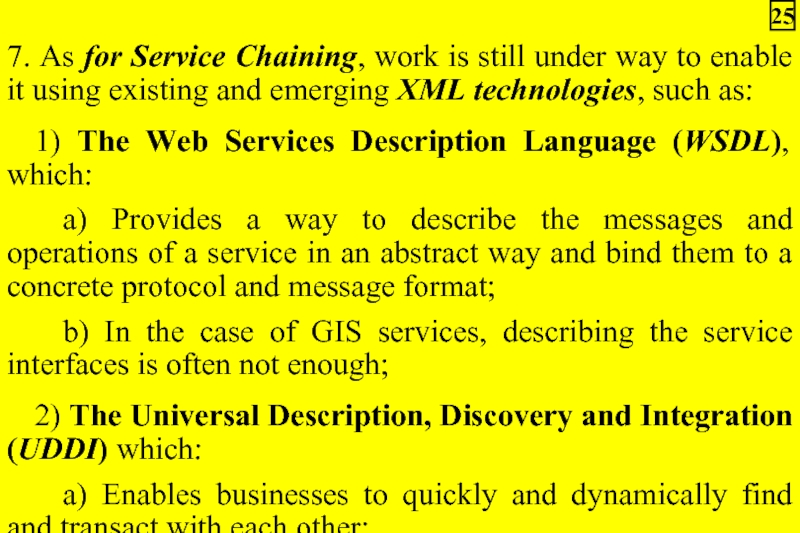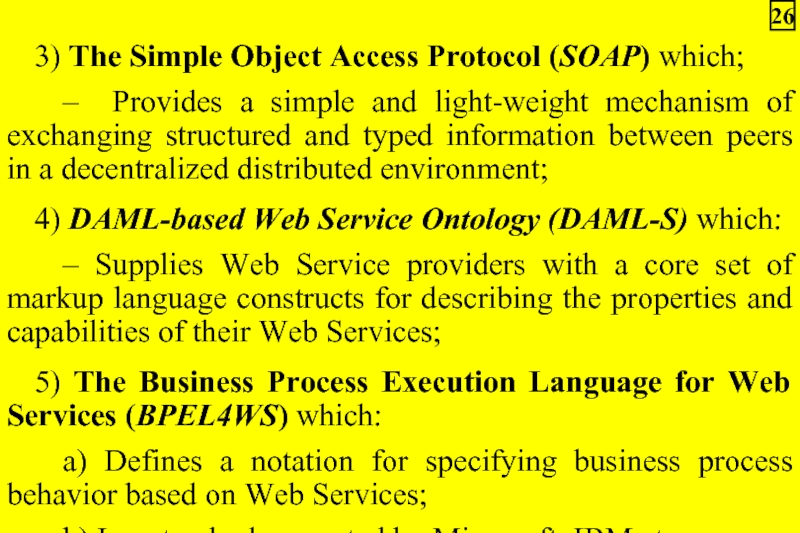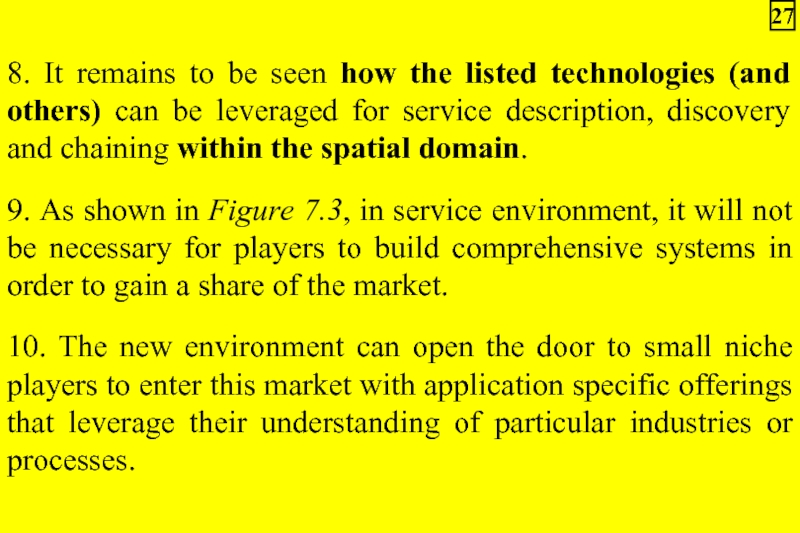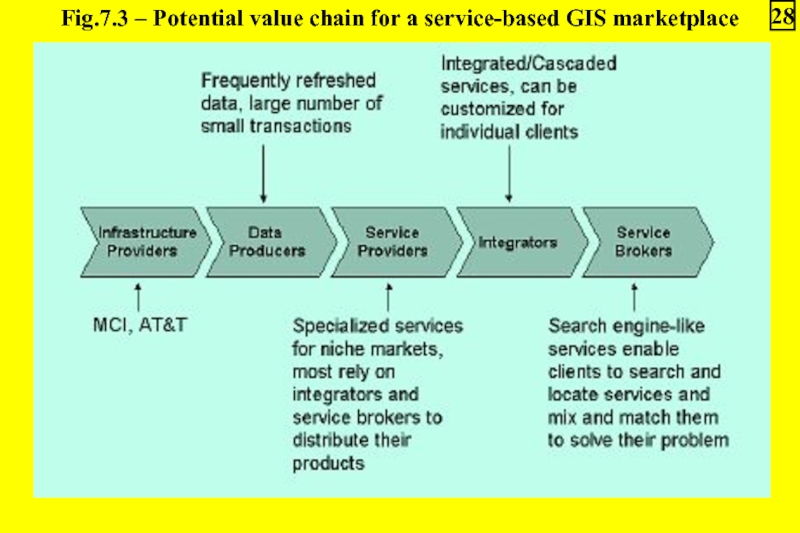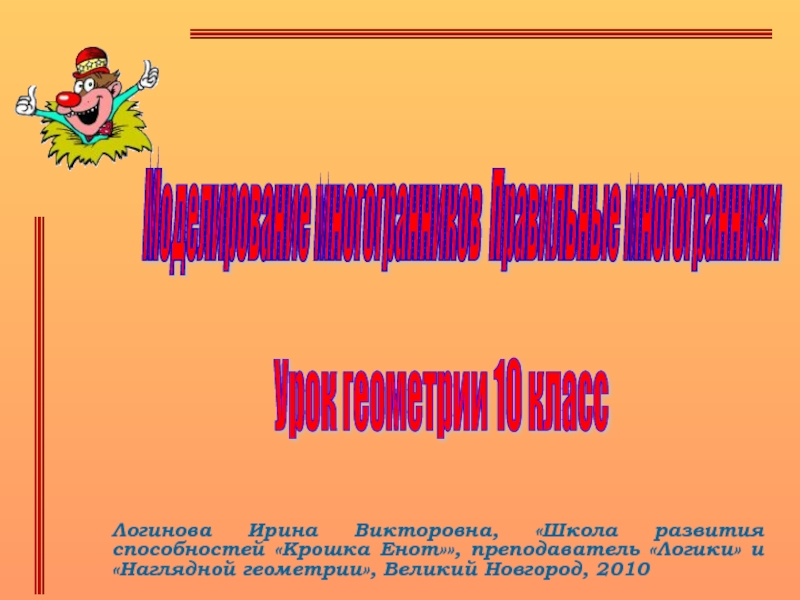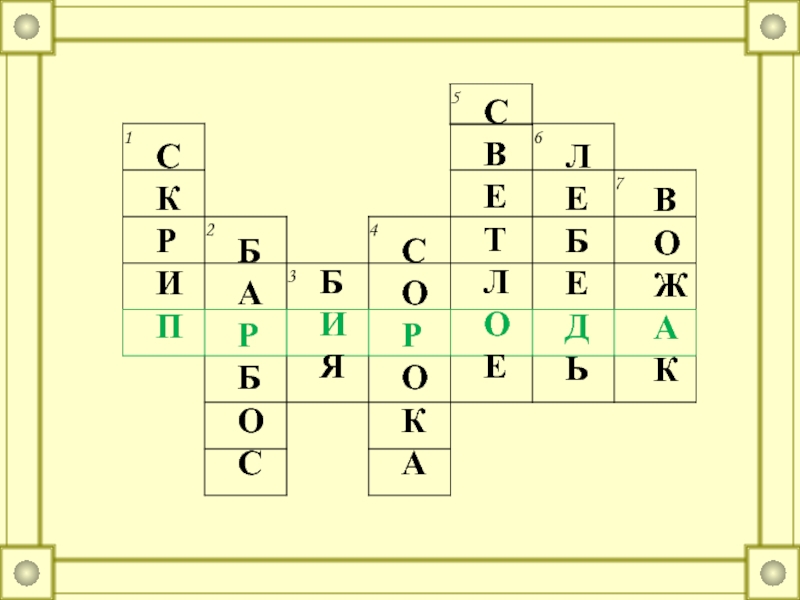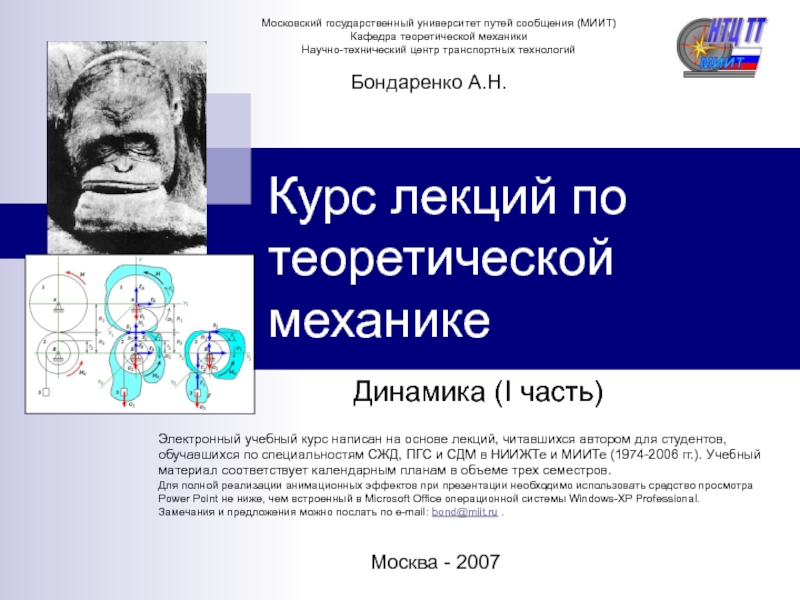- Главная
- Разное
- Дизайн
- Бизнес и предпринимательство
- Аналитика
- Образование
- Развлечения
- Красота и здоровье
- Финансы
- Государство
- Путешествия
- Спорт
- Недвижимость
- Армия
- Графика
- Культурология
- Еда и кулинария
- Лингвистика
- Английский язык
- Астрономия
- Алгебра
- Биология
- География
- Детские презентации
- Информатика
- История
- Литература
- Маркетинг
- Математика
- Медицина
- Менеджмент
- Музыка
- МХК
- Немецкий язык
- ОБЖ
- Обществознание
- Окружающий мир
- Педагогика
- Русский язык
- Технология
- Физика
- Философия
- Химия
- Шаблоны, картинки для презентаций
- Экология
- Экономика
- Юриспруденция
SDI 07 презентация
Содержание
- 1. SDI 07
- 2. 1. In the preceding themes we
- 3. 7.1. Context and rationale of SDI
- 4. 7.2. Organisational approach to SDI services
- 5. Fig.7.1 – The OGC Service Framework 5
- 6. 4. The OGC Service Framework groups
- 7. Table 7.1 – Categories of the OGC Service Framework 7
- 8. 7.2.1. Spatial Application Services: 1) Operate
- 9. 7.2.3. Spatial Data Services 1. Spatial
- 10. 3) Sensor Collection Services (SCS):
- 11. 2. Spatial Data Services also provide
- 12. 7.2.4. Portrayal Services: 1) Provide visualization
- 13. 5) Examples of such services include:
- 14. 7.2.5. Processing Services 1. Processing Services
- 15. 2) Image Processing Services, which include:
- 16. b) Image Exploitation Services: –
- 17. 3) Spatial Analysis Services: a)
- 18. 7.2.6. SDI Service Chaining 1. Chaining
- 19. 5. Indeed, most GIS applications will
- 20. Fig.7.2 – A typical Service Chaining example 20
- 21. 7. To date, three general Service
- 22. 3) Workflow-managed Translucent Chaining where: a)
- 23. 7.3. Implementation approach to SDI services
- 24. 4. By ensuring that new services
- 25. 7. As for Service Chaining, work
- 26. 3) The Simple Object Access Protocol
- 27. 8. It remains to be seen
- 28. Fig.7.3 – Potential value chain for a service-based GIS marketplace 28
Слайд 2
1. In the preceding themes we have discussed three types of
2. Additional services that extend functionality over the Web by combining data from sources described in Theme 6 are described here.
3. The application of special services, and service chaining, hold great promise in realizing true Web-based GIS interactions on data in support of decision making.
2
Слайд 3
7.1. Context and rationale of SDI services
1. Services can be defined
2. Clients can invoke services from across a network using standardized protocols independently of platform, language, or object model on which the services or the client were deployed.
3. By building applications to common service interfaces, applications can be built without a-priori or run-time dependencies on other applications or services.
4. Applications and services can be added, modified, or replaced without impacting other applications.
5. In addition, operational workflows can be changed on-the-fly, allowing rapid response to time-critical situations.
3
Слайд 4
7.2. Organisational approach to SDI services
1. As described in the OGC
2. The OGC Service Framework (shown in Figure 7.1) identifies services, interfaces and exchange protocols that can be utilized by any application.
3. The framework, which can be implemented in different ways, primarily provides a basis for coordinated development of new and extended spatial services.
4
Слайд 6
4. The OGC Service Framework groups spatial services into five categories
5. By providing a summary of these categories, this theme is intended to help you decide on the right mix of services that you need in your applications.
6. Service Chaining is distinguished as one more category of services.
6
Слайд 8
7.2.1. Spatial Application Services:
1) Operate on user terminals (e.g. desktop, notebook,
2) Are used by users to access Catalog, Data, Portrayal and Processing Services depending on the requirements and the designed implementation of the application;
3) Often provide user-oriented displays of spatial content and support user interaction at the user terminal.
7.2.2. Catalogue Services:
– Catalogue Services are described in detail in Theme 4.
8
Слайд 9
7.2.3. Spatial Data Services
1. Spatial Data Services provide access to a
1) Feature Access Services (FAS):
a) Provide access and management of feature stores;
b) Applicable implementation specification: OGC Web Feature Service (WFS) (See Theme 6);
2) Coverage Access Services (CAS):
a) Provide access and management of coverage stores;
b) Applicable implementation specification: OGC Web Coverage Service (WCS) (See Theme 6);
9
Слайд 10
3) Sensor Collection Services (SCS):
a) Provide access, manipulation and collection
b) Applicable implementation specification: OGC Sensor Collection Service (SCS);
4) Image Archive Services:
– Provide access and management of large sets of digital images and related metadata.
10
Слайд 11
2. Spatial Data Services also provide access to location-based data in
1) Directory Services:
– Provide access to online directories to find the locations of specific or nearest places, products or services;
2) Geocoding Services:
– Transform a description of a location into a normalized description of the location;
3) Navigation Services:
– Determine travel routes and navigation between two points;
4) Gateway Services:
– Find the position of a known mobile terminal from the network.
11
Слайд 12
7.2.4. Portrayal Services:
1) Provide visualization of spatial information;
2) Given one or
3) Can be tightly or loosely coupled with other services such as the Data and Processing Services;
4) Can transform, combine, or create portrayed outputs;
12
Слайд 13
5) Examples of such services include:
a) Map Portrayal Services (MPS):
–
b) Coverage Portrayal Services (CPS):
– Applicable implementation specification: OGC Coverage Portrayal Service (CPS);
c) Mobile Presentation Services etc.
13
Слайд 14
7.2.5. Processing Services
1. Processing Services are not associated with specific datasets.
2. They provide operations for processing or transforming data in a manner determined by user-specified parameters.
3. They can be tightly or loosely coupled with other services such as the Data and Portrayal Services.
4. The most common examples of processing services are:
1) Coordinate Transformation Services (CTS):
a) Convert spatial coordinates from one reference system to another;
b) Applicable implementation specification: Coordinate Transformation Services (CTS);
14
Слайд 15
2) Image Processing Services, which include:
a) Image Manipulation Services:
– Manipulate
– Are used for conducting mathematical analyses of image characteristics (computing image histograms, convolutions, etc.);
15
Слайд 16
b) Image Exploitation Services:
– Support the photogrammetric analysis of remotely
– Support the generation of reports and other products based on the results of the analysis.
c) Image Synthesis Services:
– Create or transform images using computer-based spatial models, perspective transformations, and manipulations of image characteristics to improve visibility, sharpen resolution, and/or reduce the effects of cloud cover or haze;
16
Слайд 17
3) Spatial Analysis Services:
a) Exploit information available in a Feature
b) Derive application-oriented quantitative results that are not available from the raw data itself.
4) Gazetteers:
a) Provide access to geospatial data indexed by placename rather than by coordinate locations;
b) Applicable implementation specification: Gazetteer service profile of a WFS.
17
Слайд 18
7.2.6. SDI Service Chaining
1. Chaining services can be considered as a
2. Efficient service chaining is critical to your ability to leverage and combine multiple information sources hosted by various service providers.
3. The key to achieving such efficiency relies on the use of standard interfaces and encodings in the design of the underlying services.
4. Service chaining is required when a task needed by a client cannot be provided by a single service, but rather by combining or pipelining results from several complementary services.
18
Слайд 19
5. Indeed, most GIS applications will require the chaining of multiple
6. Figure 7.2 shows a typical Service Chaining scenario where:
1) Coverage Portrayal Service (CPS) fetches several GIS coverages from different WCS services;
2) Then CPS mosaics them to portray the resulting composite image;
3) Processing Service reprojects the resultant coverage to another spatial reference system;
4) Overlay Service then supplements the coverage with features extracted from a WFS, and sends the result to the client as a rendered map.
19
Слайд 21
7. To date, three general Service Chaining methods have been identified
1) User-defined Transparent Chaining, where:
a) The user defines and controls the order and execution of the individual services;
b) Method requires deep involvement of the client, which may hinder a wide-base adoption of spatial web services;
2) Opaque Chaining, where:
a) The chaining of service is performed by a new aggregate service;
b) Aggregate services bundle static (predefined) chains of services and present them to the client as one;
c) The client loses all control over the service chaining process;
21
Слайд 22
3) Workflow-managed Translucent Chaining where:
a) The execution of the chain is
b) Mediating services can act as gateways to other services by coordinating between multiple services without necessarily storing any data of their own.
8. Chaining of spatial services (possibly in conjunction with other non-spatial services) is still considered an area of active research both from the conceptual and implementation perspectives.
22
Слайд 23
7.3. Implementation approach to SDI services
1. There are few existing standards
2. If you need to implement any of these services in your production environment, it is advisable that you first try to reuse existing interfaces to the extent possible.
3. You should also work with others in your field and with applicable standards bodies to design standard interfaces that can meet your needs.
23
Слайд 24
4. By ensuring that new services fit within the described OGC
5. In terms of supporting technologies, work is underway within OGC to define a suite of Web Service Interfaces that have explicit bindings for both HTTP GET and POST (e.g. the WMS, WFS and WCS specifications).
6. In this case, XML is very fundamental as it provides the extensibility and vendor, platform and language independence that are key to the loosely coupled standards-based interoperability.
24
Слайд 25
7. As for Service Chaining, work is still under way to
1) The Web Services Description Language (WSDL), which:
a) Provides a way to describe the messages and operations of a service in an abstract way and bind them to a concrete protocol and message format;
b) In the case of GIS services, describing the service interfaces is often not enough;
2) The Universal Description, Discovery and Integration (UDDI) which:
a) Enables businesses to quickly and dynamically find and transact with each other;
b) Do not currently support any type of spatial queries;
25
Слайд 26
3) The Simple Object Access Protocol (SOAP) which;
– Provides a simple
4) DAML-based Web Service Ontology (DAML-S) which:
– Supplies Web Service providers with a core set of markup language constructs for describing the properties and capabilities of their Web Services;
5) The Business Process Execution Language for Web Services (BPEL4WS) which:
a) Defines a notation for specifying business process behavior based on Web Services;
b) Is a standard promoted by Microsoft, IBM etc.
26
Слайд 27
8. It remains to be seen how the listed technologies (and
9. As shown in Figure 7.3, in service environment, it will not be necessary for players to build comprehensive systems in order to gain a share of the market.
10. The new environment can open the door to small niche players to enter this market with application specific offerings that leverage their understanding of particular industries or processes.
27

